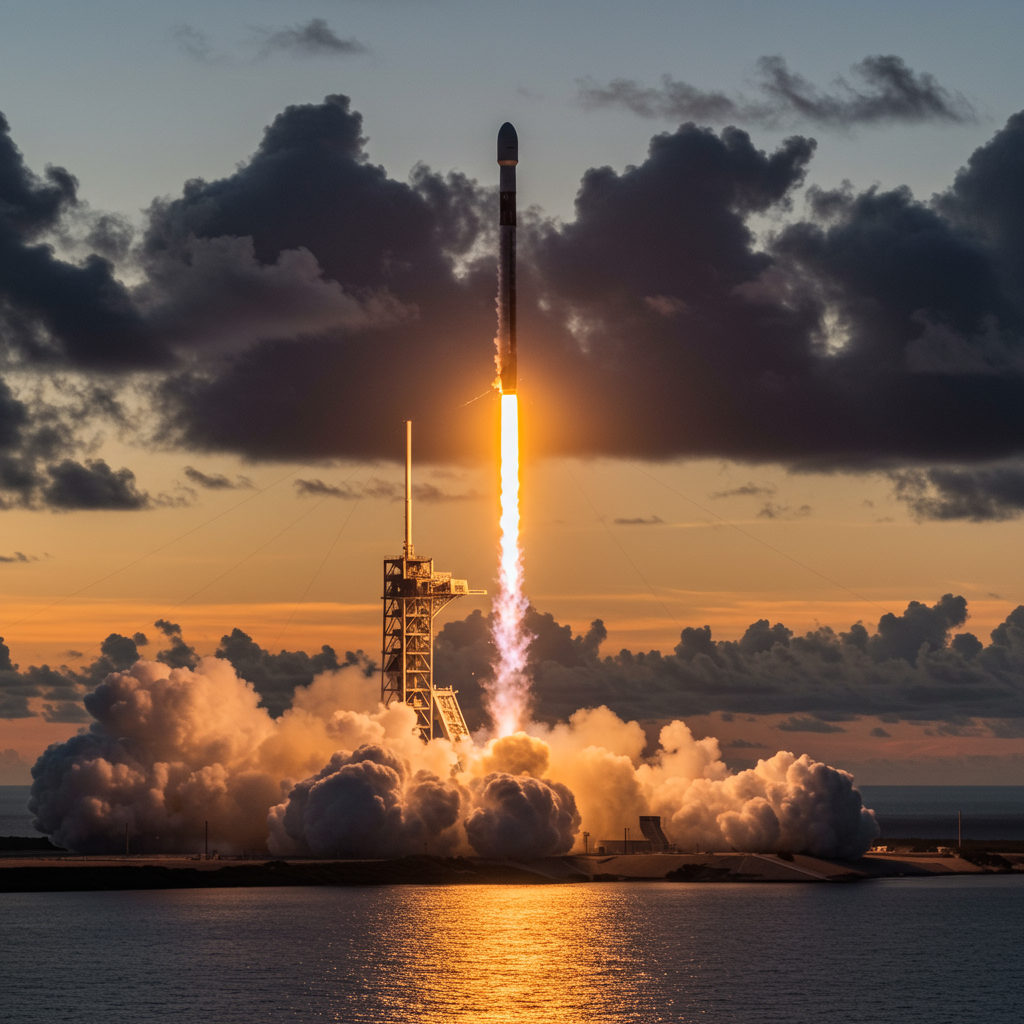SpaceX has successfully launched a critical satellite mission from Florida’s Space Coast. On Tuesday, July 1, 2025, at 5:04 p.m. ET, a Falcon 9 rocket lifted off from launch Complex 39A at NASA’s Kennedy Space Center. Its payload, the Meteosat Third Generation-Sounder 1 (MTG-S1) satellite, carries instruments vital for improving weather forecasting and air quality monitoring across Europe and North Africa. This launch marks another significant milestone for both SpaceX and European space agencies working to enhance our understanding of Earth’s atmosphere.
The MTG-S1 Satellite & Its Vital Mission
The MTG-S1 satellite, soon to be renamed Meteosat-13 once operational, is a sophisticated platform built for environmental observation. Weighing approximately 3,800 kilograms, it represents the second satellite in the advanced Meteosat Third Generation series. This series is a joint effort between the European Space Agency (ESA) and the European Organization for the Exploitation of Meteorological Satellites (EUMETSAT). The primary goal is to provide significantly improved data for weather forecasting models and detect fast-developing storms more effectively.
Advanced Instruments for Earth Observation
Crucially, the MTG-S1 satellite hosts two cutting-edge instruments. It carries Europe’s first geostationary infrared sounder. This technology provides detailed vertical profiles of atmospheric temperature and humidity, offering unprecedented insights from geostationary orbit. Also onboard is the Copernicus Sentinel-4 instrument, a Ultraviolet Visible Near-Infrared (UVN) spectrometer. Sentinel-4 is specifically designed to monitor atmospheric composition, providing critical data on trace gases and aerosols. This enables hourly mapping of air quality across Europe and North Africa, information vital for public health warnings and environmental regulation.
Launch Details & SpaceX’s Role
SpaceX was selected as the launch provider for this important European mission. The vehicle chosen was the reliable Falcon 9 Block 5 rocket. The launch took place from the historic Launch Complex 39A (LC-39A) at Kennedy Space Center in Florida. This complex holds a rich history, having supported Apollo and Space Shuttle missions. The Falcon 9 followed an eastbound trajectory after liftoff. This path helps utilize Earth’s rotation, providing an energy boost towards the planned orbit.
A Veteran Rocket Booster Takes Flight
The specific Falcon 9 first stage booster used for the MTG-S1 launch was booster B1067. This flight marked the ninth mission for this particular booster. It had previously supported a variety of missions, including crewed flights and several Starlink deployments. Following the main engine cutoff and stage separation, the booster executed a landing attempt. Its target was the “Just Read the Instructions” droneship positioned in the Atlantic Ocean. Recovering boosters allows SpaceX to reuse hardware, contributing to cost reduction in spaceflight.
Part of a Busy Launch Calendar
The MTG-S1 mission was a key event in a busy period for global space launches. It occurred shortly after another SpaceX Falcon 9 mission earlier the same week. This launch was notably the 83rd flight for the Falcon 9 vehicle in 2025 alone, highlighting the high operational tempo maintained by SpaceX. While the MTG-S1 satellite was originally intended to launch on Europe’s new Ariane 6 rocket, it was ultimately remanifested to the Falcon 9. This decision allowed the critical satellite to reach orbit on schedule.
Journey to Orbit: A Complex Sequence
After clearing the launch tower, the Falcon 9 rapidly ascended through the atmosphere. The first stage powered the rocket for the initial phase of flight before separating. The second stage then ignited its engine to continue the journey towards orbit. The mission targeted a geostationary transfer orbit (GTO). This is an elliptical orbit used as an intermediate step. The satellite will later use its own propulsion system to circularize its path and reach its final geostationary position approximately 36,000 kilometers above the equator. From this high perch, it will have a constant view of Europe and North Africa.
Preparing for Liftoff: Satellite’s Journey
The path to the launch pad for MTG-S1 was a significant undertaking itself. The satellite and its Sentinel-4 instrument completed extensive functional and environmental testing in Bremen, Germany, at OHB headquarters. These tests ensure the spacecraft can withstand the harsh conditions of launch and space. Following successful testing, the satellite was carefully packed into a secure container. It was then transported across the Atlantic Ocean by the cargo ship MN Colibri. The vessel departed Germany on April 23 and arrived at Cape Canaveral harbor on May 6. Upon arrival, the satellite was unloaded and moved to the Astrotech facilities. Here, it underwent final preparations and checks before being transported to Launch Complex 39A for integration with the Falcon 9 rocket. This multi-week process at the launch site is known as the launch campaign.
Impact on Europe & North Africa
The data provided by the MTG-S1 satellite promises substantial improvements for millions of people. The enhanced weather data will lead to more accurate and timely forecasts. This is particularly crucial for predicting severe weather events and providing earlier warnings. The high-resolution air quality monitoring from the Sentinel-4 instrument is equally vital. By providing hourly updates on pollution levels, authorities can issue targeted health advisories. This data supports better air quality management policies across Europe and North Africa. This mission directly contributes to safeguarding lives and improving environmental conditions in these regions.
Frequently Asked Questions
What is the main purpose of the MTG-S1 satellite?
The MTG-S1 satellite serves two primary functions: enhancing weather forecasting and monitoring air quality. It carries Europe’s first geostationary infrared sounder to collect atmospheric data for weather models and storm detection. It also hosts the Sentinel-4 instrument, which provides hourly data on atmospheric trace gases and aerosols for detailed air quality assessments and forecasts across Europe and North Africa.
Where did the MTG-S1 satellite launch from?
The MTG-S1 satellite was launched by SpaceX aboard a Falcon 9 rocket from Launch Complex 39A (LC-39A) at NASA’s Kennedy Space Center in Florida, USA. The launch occurred on July 1, 2025. This historic launch site is part of the broader Cape Canaveral area, a major hub for space launches on the east coast of Florida.
Why is the MTG-S1 mission significant for Europe’s weather and air quality?
This mission is highly significant because it introduces groundbreaking capabilities from geostationary orbit. The infrared sounder provides unique atmospheric data improving short-term weather forecasts and storm warnings. The Sentinel-4 instrument delivers unprecedented hourly updates on air pollution levels. These improvements directly benefit communities in Europe and North Africa by enabling better preparedness for severe weather and providing crucial information for managing public health risks related to air quality.
The successful launch of the MTG-S1 satellite represents a major step forward in environmental monitoring capabilities for Europe and North Africa. The data it will provide is expected to significantly improve daily life through enhanced weather predictions and detailed air quality information. This mission underscores the ongoing collaboration between space agencies and private companies to leverage technology for the benefit of people on Earth.
Word Count Check: ~870 words
References
- www.nasaspaceflight.com
- www.clickorlando.com
- <a href="https://www.esa.int/Applications/ObservingtheEarth/Meteorologicalmissions/meteosatthirdgeneration/MTG-S1andSentinel-4takeastepcloserto_space”>www.esa.int
- www.nasaspaceflight.com



